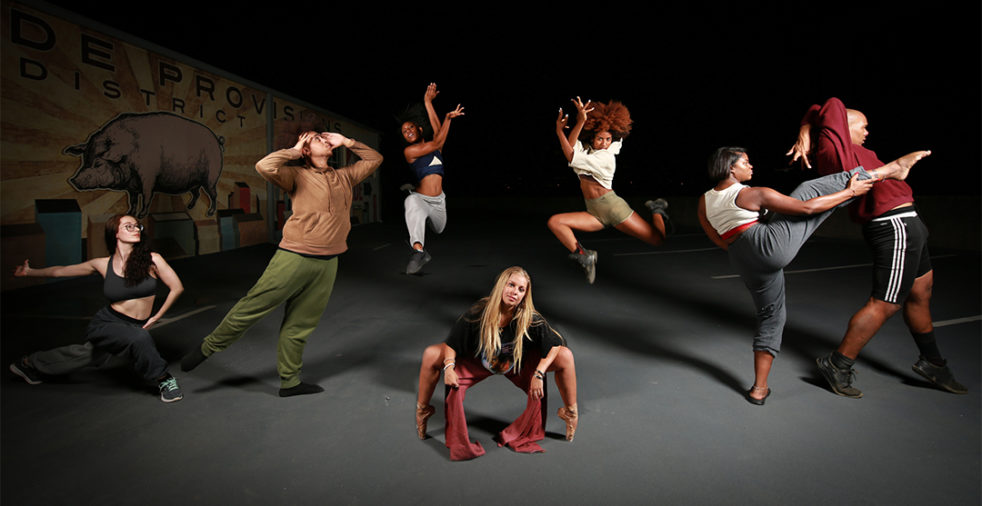The nights of Jan. 25 and 26, the Ferst Center hosted “Skid,” a modern interpretive dance show performed by Atlanta’s recently established Komanse Dance Theater.
The two act show features a broad variety of different dancing and musical styles, from ballet to hip hop dancing, jazz to trap music and everything in between.
The Friday night show was well attended and audience engagement was encouraged, leading to an immersive and energetic viewing experience.
This impressive audience engagement seemed partially to be fueled by the thoughtful curation of the show’s music — song choices were vibrant and dynamic, and the show’s many swings from emotionally low to emotionally high and from slow to fast were timed
perfectly to keep the audience’s
full attention.
The dancers — of which the Komanse Dance Theater has many — fed off of the audience energy and the music. Each dancer turned in inspired performance after inspired performance. Watching the show, the viewer becomes acutely aware of the youth of the theater — the group has been around less than a year and their two performances at the Ferst Theater were their first ever.
The troupe’s youth is reflected in the obvious excitement and hunger of the dancers, and the group’s sense of ambitious energy is likely an echo of that of its founder and Artistic Director, Raianna Brown. Brown is a lifelong dancer and is currently an Industrial Engineering student at the Institute, while also studying dance at Emory University.
“Skid” is a visual masterpiece, with enchanting choreography executed by dedicated and skillful dancers who clearly care deeply for the work they are doing. Most students probably have very little experience with modern dance, and “Skid” seems a great introduction to the unique art.
Where “Skid” comes up short is in its execution of its artistic vision. The show purports to be “a celebration of the vulnerability and strength of humanity” that aims to take “a provocative look at homelessness and gentrification in the Metro Atlanta area.”
This central theme is at times addressed subtly and artistically by the song choices in the show, while at others it is addressed either not at all or in an on-the-nose fashion which can almost be a little insulting to the viewer.
For instance, an audio recording of a man saying that humans need “love” above all else is played repeatedly throughout the show, forming the thesis statement of the work. Bluntly stating the idea of the show like this is fine, and doing it through an audio recording is slightly creative, but the rest of the show must then support that thesis and expand upon it through all of the artistic elements present. The thesis statement cannot itself also be the bulk of the argument presented by a show.
The songs do a great job of supporting the thesis, and there are some segments of live spoken-word poetry which expand upon the topic, but it is difficult for the viewer to identify the contribution which the dancing itself makes to the conversation.
Sure, the dancing follows the music in tone, tempo and style, but beyond simply mirroring the sounds, it does not add much depth to the messages the viewer picks up on.
Experts on modern dance would likely tell the viewer that he is missing the point of just about everything and that every aspect of the dancing has deep significance to the themes of the show, but it is hard for a layperson to believe that a room full of such experts would reach any consensus on the meaning of the dancing.
Certainly, art should be open to interpretation to some extent, but the dancing in “Skid” is so open that it is probably best viewed as a purely aesthetic art.
Focusing on aesthetics is fine, and the interpretive nature of “Skid” is probably largely a limitation of the medium of dance rather than due to the quality of the specific show. Still, the theater claims that the show examines homelessness, gentrification and other themes, making it fair to hold the dancing to some
artistic standard.
None of this is to say that “Skid” is anything other than a wonderfully enjoyable show. It is beautiful, engaging and enthralling. What’s more, it has a message to offer its viewers, even if it is conveyed almost exclusively by the music and spoken word.
Considering that “Skid” is the Komanse Dance Theater’s first ever show, Brown and her troupe did an incredible job. If the group can manage to show at least a fraction of the energy and enthusiasm they exhibited in their first effort in future shows, whatever they put out next will most likely be well worth checking out.
